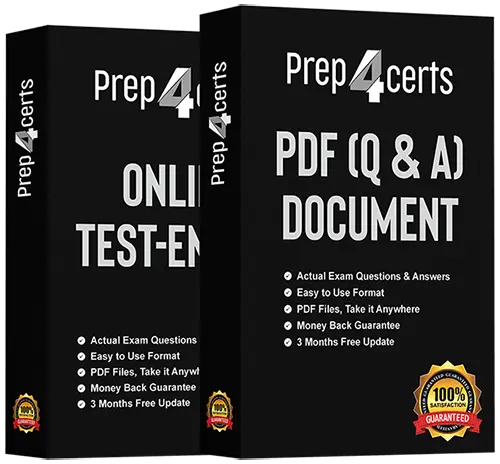
| Exam Code | E_S4HCON2019 |
| Exam Name | SAP Certified Technology Specialist - SAP S/4HANA Conversion and SAP System Upgrade |
| Questions | 73 Questions Answers With Explanation |
| Update Date | November 08,2024 |
| Price |
Was : |
Are you ready to take your career to the next level with SAP Certified Technology Specialist - SAP S/4HANA Conversion and SAP System Upgrade? At Prep4Certs, we're dedicated to helping you achieve your goals by providing high-quality E_S4HCON2019 Dumps and resources for a wide range of certification exams.
At Prep4Certs, we're committed to your success in the SAP E_S4HCON2019 exam. Our comprehensive study materials and resources are designed to equip you with the knowledge and skills needed to ace the exam with confidence:
Start Your Certification Journey Today
Whether you're looking to advance your career, expand your skill set, or pursue new opportunities, Prep4Certs is here to support you on your certification journey. Explore our comprehensive study materials, take your exam preparation to the next level, and unlock new possibilities for professional growth and success.
Ready to achieve your certification goals? Begin your journey with Prep4Certs today!
You are performing an SAP S/4HANA conversion of the development system. Which credentials do you use in which system to perform the adjustment of programs and other non-dictionary repository objects (SPAU)? Please choose the correct answer.
A. Credentials of a named user in client 000 of the shadow system
B. Credentials of a named user in the development client of the development system
C. Credentials of user DDIC in client 000 of the shadow system
D. Credentials of user DDIC in the development client of the development system
During the configuration of the DMO for SUM, how does the tool behave if option "Do not compare table contents" is selected regarding table comparison? Please choose the correct answer. Response:
A. It performs a comparison on selected tables using check sum.
B. It performs a comparison on all tables using row counts.
C. It performs a comparison of all tables using check sum.
D. It does NOT perform any table comparison.
Which steps should be performed during the adjustment of dictionary objects (SPDD) in the development system, before SUM continues? There are 2 correct answers to this question. Response:
A. Create "modified* versions of the objects that you need to adjust
B. Release the transport request containing the modification adjustment
C. Assign the transport request as a modification adjustment transport
D. Manually activate the adjusted dictionary objects
You are performing an upgrade with SUM using DMO to an AS ABAP 7.50 based SAP system. You entered a specific number of R3Ioad processes during Roadmap step "Extraction". Where can you change this during the migration via the Utilities option of the SUM UI? There are 2 correct answers to this question Response:
A. In SUM Phaselist
B. In Process Control Center
C. In SUM Parameters
D. In DMO Migration Preparation
You want to use the downtime-optimized data conversion for your SAP S/4HANA conversion. What is the main difference from a standard SAP S/4HANA conversion? Please choose the correct answer. Response:
A. An additional temporary database is used during uptime
B. Dedicated application tables are migrated in uptime
C. TABIMJJPG is executed in uptime
D. The repository is migrated in uptime
What do you need to know about the SAP ERP Upgrade and Update Guide? There are 2 correct answers to this question. Response:
A. It contains a troubleshooting section
B. It is target release specific
C. It contains a section "free space requirements"
D. It is a database-specific document
Which maintenance events are possible with SUM for an SAP system based on AS ABAP 7.40 and above? There are 3 correct answers to this question.
A. Dual Stack split
B. Support Package Stack update
C. Database migration
D. Release upgrade
E. Homogenous system copy
You are planning to use DMO of SUM to perform an "inplace-migration" to SAP HAN
A. The source system is non-Unicode and the target database is a scale-out system. What do you need to consider? There are 2 correct answers to this question.
B. Network capacity between exporting and importing R31oad processes must be considered.
C. SAP HANA Landscape Reorganization requires a manual step to edit a file.
D. The target database size increases temporarily because of the Shadow Repository.
E. Unicode conversion is part of DMO only in case of target version AS ABAP 7.40 or 7.31
You want to perform an SAP S/4HANA conversion using SUM with DMO. Which steps run before the beginning of the technical downtime, independent of your SUM configuration? There are 3 correct answers to this question. Response:
A. Generation of the new ABAP loads in phase RUN_SGEN_GENER8
B. Import of upgrade and language data from the download directory in phase TABIM UPG
C. Activation of dictionary objects in phase ACT_UPG
D. Creation of application tables in the SAP HANA database in phase EU_CLONE_MIG_DT_CREATE
E. Import of dictionary objects from the download directory in phase DDIC_UPG
During a SUM run you vivant to check if the phase SHADOW_IMPORT_INC is still running properly. Where can you find information about this? There are 2 correct answers to this question. Response:
A. Check for running batch jobs in the shadow system via Job Overview (SM37)
B. Check for running R3trans processes on the host of the primary application server
C. Check for running R31oad processes on the host of the primary application server
D. Check for the latest log files in the SUM directory, subdirectory ABAP, subdirectory tmp